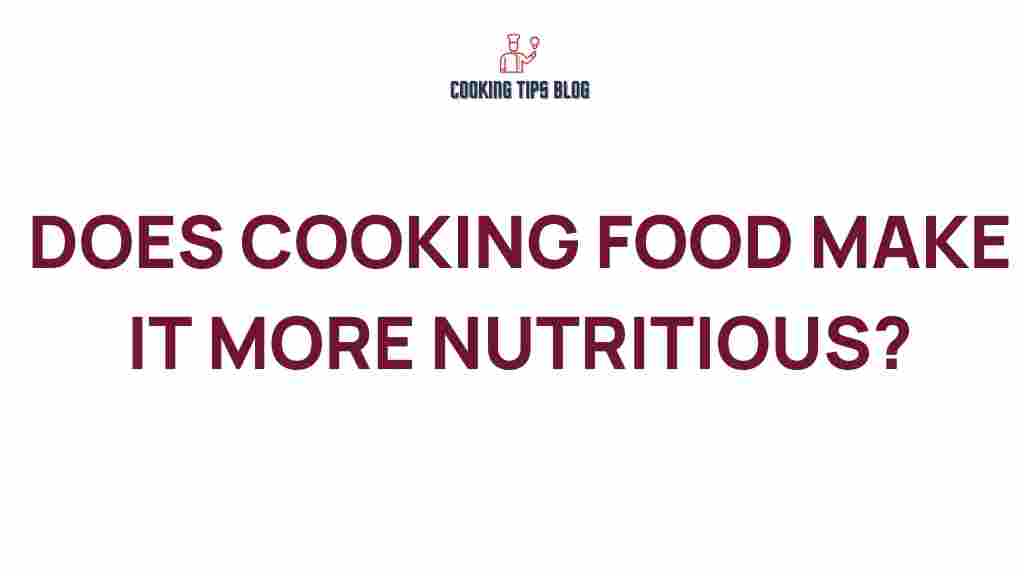Does Cooking Food Enhance Its Nutritional Value? Discover the Truth About Cooking
Cooking is an age-old practice that transforms raw ingredients into delicious meals. However, beyond flavor and texture, many people wonder: does cooking food enhance its nutritional value? This article delves into the relationship between cooking and nutrition, exploring various cooking methods, their effects on different nutrients, and how to maximize the health benefits of your meals.
The Science Behind Cooking and Nutrition
Cooking food changes its chemical structure, which can influence the availability of certain nutrients. Here are some key points about how cooking affects nutritional value:
- Breakdown of Cell Walls: Cooking can break down tough plant cell walls, making it easier for your body to absorb nutrients.
- Reduction of Antinutrients: Some foods contain antinutrients like phytic acid and oxalates that inhibit nutrient absorption. Cooking can reduce these compounds.
- Enhanced Digestibility: Cooking meat and legumes makes them easier to digest and helps your body utilize their protein more effectively.
- Destruction of Pathogens: Cooking kills harmful bacteria and parasites, reducing the risk of foodborne illnesses.
Different Cooking Methods and Their Nutritional Impact
Not all cooking methods are created equal. Here’s a closer look at how various techniques can affect the nutritional quality of your food.
1. Boiling
Boiling is a common cooking method, but it can lead to nutrient loss, particularly water-soluble vitamins like vitamin C and some B vitamins. To minimize nutrient loss:
- Avoid overcooking.
- Use minimal water.
- Consider using the cooking water in soups or sauces.
2. Steaming
Steaming is a gentler cooking method that helps retain more nutrients compared to boiling. It preserves the color and flavor of vegetables, making them more appealing. To maximize benefits:
- Steam vegetables until just tender.
- Use a steamer basket to avoid direct contact with water.
3. Sautéing and Stir-Frying
These methods use oil and high heat, which can enhance the absorption of fat-soluble vitamins (A, D, E, and K). Here are some tips:
- Choose healthy oils like olive or avocado oil.
- Add garlic or onions for flavor and additional health benefits.
4. Baking and Roasting
Baking and roasting can create flavorful meals and retain nutrients, especially if you avoid excessive cooking times. Consider the following:
- Use parchment paper to reduce sticking and burning.
- Roast vegetables at high temperatures to enhance flavor without overcooking.
5. Grilling
Grilling adds a smoky flavor and can be a healthy cooking option if done correctly. However, be cautious of potential carcinogen formation. Tips include:
- Marinate meats to reduce harmful compounds.
- Grill vegetables alongside for a nutrient-rich meal.
Raw vs. Cooked: What’s Better?
The debate between raw and cooked foods is ongoing. Here are some considerations:
- Raw Foods: High in certain enzymes and nutrients, but some nutrients may be less bioavailable.
- Cooked Foods: Often more digestible, with enhanced nutrient absorption, particularly in certain vegetables like tomatoes (which release more lycopene when cooked).
Maximizing Nutritional Value Through Cooking
To get the most out of your cooking, follow these strategies:
- Cook Whole Foods: Focus on whole, unprocessed ingredients for maximum nutrients.
- Use Minimal Water: When cooking vegetables, use just enough water to steam or sauté, reducing nutrient loss.
- Cook in Batches: Prepare large quantities of meals to save time and ensure you have healthy options ready.
Troubleshooting Common Cooking Challenges
Even with the best intentions, cooking can sometimes lead to nutritional pitfalls. Here are some common issues and their solutions:
1. Overcooking Vegetables
Overcooked vegetables lose their vibrant color and valuable nutrients. To avoid this:
- Set a timer to remind you when to check for doneness.
- Use the fork test to check tenderness without overcooking.
2. Nutrient Loss in Cooking Water
If boiling vegetables, the cooking water may contain lost nutrients. Instead of discarding it:
- Use it in soups, sauces, or to cook grains.
- Consider steaming vegetables instead.
3. Uneven Cooking
Uneven cooking can lead to some nutrients being lost while others remain intact. To ensure even cooking:
- Cut food into uniform pieces.
- Stir frequently when sautéing or stir-frying.
Conclusion
So, does cooking food enhance its nutritional value? The answer is both yes and no, depending on various factors including the method of cooking and the types of food. Cooking can enhance the bioavailability of certain nutrients while reducing the levels of others. By understanding the science behind cooking and choosing the right methods, you can maximize the nutritional value of your meals. For more tips on healthy cooking practices, check out this comprehensive guide.
Remember, a balanced diet combines both raw and cooked foods, and experimenting with different cooking techniques can lead to delicious, nutrient-rich meals that support your health.
For more information on nutrition and healthy eating habits, visit the USDA’s MyPlate website.
This article is in the category Healthy and created by Cookingtipsblog Team
